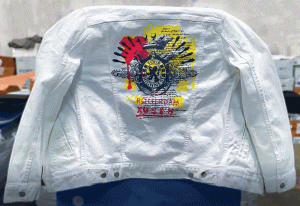A direct hit: How DTG printers are helping pros meet the moment

Direct-to-garment (DTG), is expanding beyond T-shirts. Custom printing can be done on items with higher margins such as jackets. Photos courtesy Roland DGA
By Kitt Jones
The increased use of direct-to-garment printing (DTG), has been one of the biggest changes to the industry in recent years. A large part of this change is due to a growing trend in customization and personalization, accompanied by the rise of e-commerce and “one-stop shops” offering customers a wide range of apparel resources.
Despite the impact of the pandemic, DTG printing product sales reached US$202 Million (C$253million) in 2021. The global DTG printing market is expected to grow at 8.3% annually over the next 10 year.1
Today’s print shop clients are often looking for specialty printed and short-run apparel along with their graphics, and DTG printers have emerged as a critical technology. New DTG printers from manufacturers are proving to be a valuable resource for their in-house resources.
Managing demand
Many print shops are unable to offer these products internally because customers demand more DTG products like T-shirts and hats. To satisfy their clients’ requests, print service providers (PSPs) have been outsourcing their DTG production—which can constrain the shop’s ability to control quality, timing, and costs.
Printer manufacturers developed DTG printing technology to address these needs. DTG printing is now more flexible and accessible than ever thanks to these changes. Today’s DTG printers are both powerful and versatile, providing the on-demand production capability needed to help PSPs fulfil custom and short-run orders in-house.
Technology evolution in DTG
DTG printer owners have discovered ways to increase production speed through various pre-treatment and heat pressing methods over the past few years. Although this technology is getting more affordable and faster, it can only be used to produce one platens of printers.
Today’s improved inks and more comprehensive software are important for increasing the speed and efficiency of DTG printing. Flexibility in print production offers companies the opportunity to create a variety of products and stand out from their competitors. This is where the real breakthrough lies.
DTG printing technology has been developed by printer manufacturers. It allows for faster and more efficient production of a wide range of substrates and materials. Roland DG released a DTG Printer with a 1346.2×1625.6-mm (53 x 64 in.). A bed and a 203.2mm (8-in. The Z axis allows users to print multiple shirts simultaneously or larger products like blankets, jeans and towels. Print shop owners will see a rise in profitability due to the versatility and power of this type of printer.